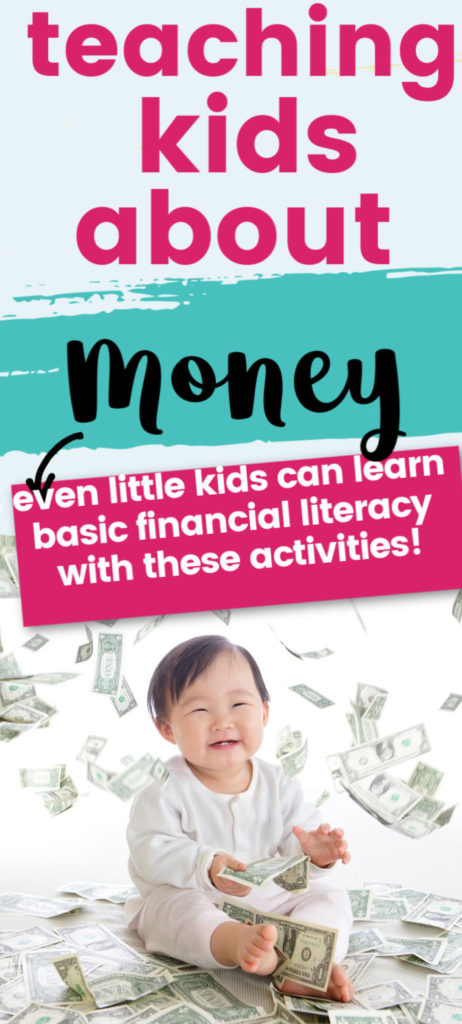Financial Literacy for Kids under 10: How to make sure that your kids grow up to be responsible with money
American’s aren’t very confident when it comes to some aspects of money management. Sure, most people are able to balance their checkbook and pay bills on time. But just 63% of men and slightly over half of women feel confident in the process of taking out a loan.
Money management isn’t just about paying bills on time. There are plenty of costly financial pitfalls that can surprise young adults who weren’t educated on personal finance as kids and teens. Mistakes like missing a credit card payment or having a bill go to collections can have serious and long-term financial ramifications.
Young adults also make choices, like choosing a college major, that could impact their financial lives for years in the future. For example, a chemical engineering major has a median starting salary of $63,200. On the other hand, a chemistry major can only expect to make $42,600 out of graduation. That’s a huge difference for very similar majors. Without teaching money management for kids, they won’t necessarily realize the ramifications of choosing a major until much later.
It’s extremely important to emphasize financial literacy for kids.

How do I teach my child financial responsibility?
Teaching your child about financial responsibility is a gradual process that will build on itself from age one to 18.
Start Early
You can start teaching preschoolers about money. When you address money in an age-appropriate way, your child will be familiar with money as a concept from an early age. Once you’ve established the basics of money, you can progressively build on that foundation with more advanced concepts as your child gets more mature.
Gradually Build Complexity and Responsibility
For very young kids, financial literacy mostly involves learning about money. As your child grows, though, you can introduce more abstract concepts (bank account vs piggy bank). You can also give your child more responsibility as they get older. An elementary school child can use their own money for “fun” purchases while an older teenager can be trusted to handle most of their budget.
Talk about Money Openly
Chase found in a 2018 survey that only 56% of American parents had talked to their children about money. Even fewer parents have given their kids basic information about credit – just 32% of parents had told their children about credit scores. This statistic seems to apply across different levels of wealth, too. Merrill Private Wealth Management found that only one third of Americans with more than $3 million in investable assets had talked with their children about money. Money might be right up there with religion and politics as a taboo topic, but we’ll never be able to teach kids financial responsibility with an open, honest conversation about money.
Educate kids on different experiences with money
I think it’s incredibly important for kids to understand that different people may have different financial situations than their own families. I make sure my kids are aware that there are some families that make more than we do, and some that make less. It’s not a taboo topic. Instead, it just becomes a fact that we talk about and move on. Ignoring financial inequality does not make it go away. I hope that by educating my kids about different levels of wealth and income, I’ll help them become more aware of their own choices and more empathetic to the challenges of others.
Teaching preschoolers about money
Financial literacy for preschool children is all about the basics! They can’t grasp abstract concepts yet, so your goal is teach them what money is, how you get it and what it’s used for.
Introduce preschoolers to physical money
Show your preschooler bills and coins. Explain that they are worth different amounts of money. Have your preschooler group the coins into different sizes and colors. Let them look at the bills.
If your child is starting to learn to count, you could ask them to count the number of coins or bills. You could also teach them that some bills are worth more dollars than other bills.
At this age, the concept of cents and change is a bit difficult so I wouldn’t push it for preschoolers.
Show kids how to use money
Talk about money with kids when you pay for something at the store. Try to use physical money from time to time so they see you exchanging money for something. It’s tough in this day and age because most of us rarely use cash. If you’re anything like me, you do most of your shopping online too. But I think it’s important to demonstrate the transaction for kids from time to time.
Shopping is a great opportunity to talk about the exchange with your kid. You could say, “I’m paying eight dollars for this book, kiddo” so they realize that you are giving someone money and receiving something in return.
Talk to kids about how to earn money
I talk to my kids a lot about work and earning money. When they ask why I have to work, I tell them that I work to earn money. We also talk about people who sell items for money, like farmers and crafters. Some people perform a service and some people sell physical goods.
They might not fully understand this concept until they can start earning for themselves, but I think it’s important to sow the seeds early.
Financial literacy activities for elementary students
When kids reach elementary school age, they can start doing some simple activities to learn about money. The best way for kids to start learning is by helping them learn about earning, saving and spending money.
Give them an allowance
There’s a big debate over how and whether to give kids an allowance. I like the idea of giving kids an allowance because it helps them learn about earning, saving and spending money. They can start small, but they’ll learn concepts that they can apply to money management throughout their lives. Experts say that you can start giving your child a small allowance around age 5-6.
Allowance for Regular Chores
Some families decide to tie money to the child completing chores around the house. On one hand, this shows kids a direct link between work and money. It’s also somewhat simple. Do the chores and you get your allowance. Skip the chores and you don’t. However, some parents don’t like paying children to do chores when the adults in the house do chores without getting paid. Many argue that kids should be doing chores to contribute to the household, not to earn an allowance.
Allowance for Extra Chores
Other parents give their children money for doing extra chores. Your kids still have to complete their regular chores, but they can earn small amounts of money if they take on additional tasks. This approach has the benefit of relating money to work while setting aside some chores that have to be done to contribute to the household. The challenge with this approach is finding time for kids to do extra work and keeping track of how much they earn.
Allowance Not Tied to Chores
Still other families give their kids a set allowance without specifically tying it to chores or housework. This allows parents to teach their children about money, while separately also showing them that everyone contributes to the household by doing chores.
Hybrid Allowance
If you aren’t sure which approach to pick, you can try a hybrid approach to allowance. When you go with a hybrid allowance, you can give your child a set amount each week or month and allow them to earn additional money by completing extra household chores.
Spend, Save and Share Allowances
Talk with kids about three different “buckets” they can put their money in: Spend, Save and Share. The Spend category can be used immediately for small purchases, like candy or books. The Save category can be used to save for a more expensive item, like a big toy or video game. The goal of the Save category is to help your child learn to be patient as they save money over time. Finally, the Share category is an amount of their allowance that children can spend on someone other themselves.
For elementary school kids, it’s easiest to set up three different jars. Decide how much you’d like your kids to put into each jar. Help them count the money and put it in the appropriate jar.
When your kids are saving for a big purchase, they can also learn by counting their money periodically. This is a great way to reinforce what they’ve learned about currency.
Kids can practice shopping
Once you child is ready to make a purchase, have them make the transaction themselves. This is a big deal! It involves choosing the item they want to buy and finding a cash register. They have to talk with a grownup and count out the money to pay. Once they’ve paid, ask them to count their change as well.
If you don’t often buy items in cash (guilty), this is a great chance for your child to visualize how money is used to pay for things.
Money Management for Kids
Financial literacy for kids doesn’t have to be complicated! Do some simple activities with kids under 10 and you’ll help them start learning basic financial literacy from an early age. So many adults are afraid to think about their money, which is why it’s so important to demystify earning, spending and saving from an early age. By steadily increasing your child’s responsibility level with money, you’ll help them prepare for bigger money management challenges as they mature!





